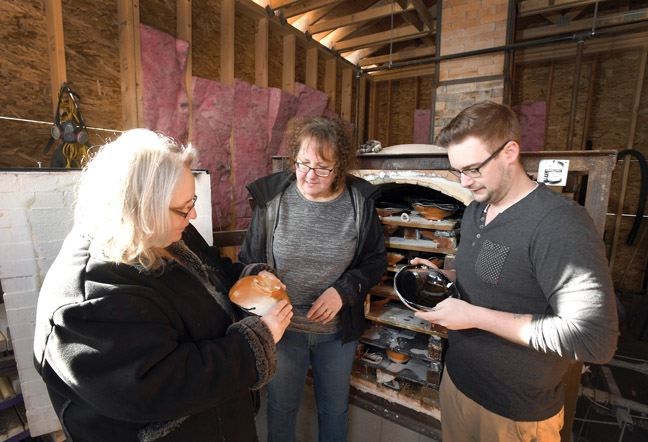As it is with people, sparks can also fly between businesses.
When a crane lowered the enormous open-faced oven into place at Prince George's new downtown pizza restaurant, it became the most famous fire chamber in the city.
It was not the first - Earl's Restaurant had the first forno oven in the known history of local dining.
It was not the biggest - the bread oven of Red Rooster Artisan Bakery has more mass.
But it was exotic and the showpiece of Betulla Burning Pizzeria on Third Avenue. It immediately attracted dining crowds like moths to its open, sweet-smelling, birch-fueled flame.
While the food fans lined up at this indoor urban campfire, the Betulla Burning management team was feeling the exact same kind of pull towards another industrial fireplace also erupting with creativity. They smile at the reminder of this petite kindred spirit each time they clear the tables, wash the dishes or set the next placings. A lot of the crockery in the restaurant was lovingly shaped out of this area's very soil.
A small clay mine on the shores of the Fraser River supplied Carlson Pottery with the wet wonder dough that, once shaped, glazed and baked, becomes the handmade plates and bowls in the pizzeria. That baking is done in another highly specialized and painstakingly constructed oven.
Leanna Carlson's pottery kiln is unlike any other in the region. She and potting partner Karen Heathman - both of them masters of the craft - were commissioned by Betulla Burning to forge a partnership. It was signed on paper then set on fire.
"Our whole restaurant operates on the philosophy of using as much 'local' as we possibly can," said Betulla Burning executive chef Brian Quarmby. They went beyond the menu.
"Our food has to go on plates, that is part of the experience. The food and the plate form a relationship that affects the taste and enjoyment. I looked around to find plates that went with our food, I wanted to know what was available, and I ended up finding out about Leanna."
"I'll be honest. It's fun for us, too, when we fire," said Carlson. "There's a whole life force that happens. The heat is intense and the whole kiln expands. It swells when it gets hot."
In that inferno (fueled mostly by soda) Carlson and Heathman baked their handmade plates and bowls - 60 each - that are already in use at the restaurant.
"I love seeing people post pictures on social media of their food (while eating at Betulla Burning) and it's one of our plates," Heathman said.
"We have a lot of pride in this. They are all handmade, so they take a little longer than throwing them on a wheel. We've never done this before, in this kind of way, but it is an extension of what we've done in the past. We know how to hand-build and we do soda burning, but we've never taken on this kind of volume commission before."
Betulla translates from Italian as "birch" which is the biofuel used in the pizzeria's oven.
Although Carlson's kiln is a soda burner, it is capable of also energizing other materials so for the sake of symbolism, the potters fired up their oven with a stack of ceremonial birch.
"Now that they know our ideology and they've done so much already, I expect we will keep going back to Leanna and Karen for other things we need," said Quarmby. He laughed that all this creative effort went into this artisan crockery when the pizza itself is popped into their oven for about two minutes.
The plates and bowls started out as grey mud on the riverbank. It was hand dug and transported to Carlson Pottery, mixed in a pug mill, stored, then shaped into the crockery beginning with a process called wedging followed by pushing the clay into the shapes required. It is then left to dry. (This process can take a matter of months, depending on the items in question.)
The plates and bowls in raw form are then fired in a bisque kiln as an initial drying step in preparation for glazing and soda firing in the mega-kiln. So intense is Carlson's soda kiln that it had to be certified by the BC Safety Authority, and the BCSA had to create protocols as there were no templates elsewhere in B.C. to which they could look.
"When you add the soda, it poofs up and roars," Carlson said. "They call that a 'kiln dragon' because it is like a living thing, actually breathing."
"It's so beautiful, when the oven is fired," said Heathman. "There is a lot of science to it, and a lot of beauty."
The soda fire's temperature is about 1,282 Celsius, compared to the birch fire at the restaurant at about 482 C.
There might not be any pure science to back it up, but one hypothesis might follow that the love and skill put into the making of the crockery makes the equally skillful food taste even better.



